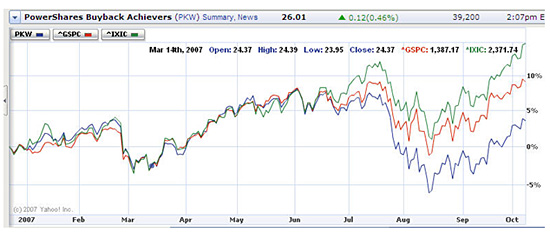A piece in Seeking Alpha, “Buybacks: A Wolf In Sheep’s Clothing,” by Matthew Hougan at Index Universe, does a nice job of debunking the myth that stock buybacks are a positive indicator for price performance.
I’ve always had trouble with the logic of buybacks. If a company doesn’t believe that it has attractive enough prospects to invest its surplus cash in the business of the business, it should dividend it out to shareholders. But in our growth-obsessed world, dividends have become an admission of weakness, while stock buybacks peculiarly aren’t treated that way by the media. But the story below suggests that investors are wising up:
The chart below compares the PowerShares Buyback Achievers ETF (PKW) (in blue) with the S&P 500 (red) and Nasdaq Composite (green), since the launch of PKW in December 2006. PKW holds the stocks of companies engaged in large-scale corporate buybacks. So far, it is trailing the S&P 500 by more than 5% since inception, and the Nasdaq Composite by more than 10%.
I’m not picking on PowerShares’ fund specifically. The idea that stocks engaged in corporate buybacks do well is one of those old investment truisms, and it’s no surprise that there is an ETF today tied to the concept.
Instead, I think the driving force behind corporate buybacks has changed… and the impact of buybacks on the market has changed as well.
In the good old days, companies did buybacks mostly in extraordinary circumstances, like when the stock fell excessively in reaction to relatively minor news. Now, however, buybacks are almost a line item in corporate budgets. X dollars for salaries, Y dollars for office supplies and Z dollars for corporate buybacks.
And that’s bad news for shareholders. Why? For one, buybacks are used to cover up costly options schemes that would otherwise dilute the company’s stock. It’s a neat trick to report profits and then use those profits to cover the real expense of an options program.
But just as importantly, as I’ve written before, buybacks favor management over current shareholders. Corporations have two choices on how to return money to shareholders. They can pay it out as dividends to current shareholders, or they can buy back stock. The problem with buybacks is that they raise the value of both existing shares and shares that have yet to be issued, aka options. Buying back stock today increases the value of the options that executives will cash in tomorrow. And faced with the option of choosing buybacks vs. dividends, not surprisingly, most corporate officers are choosing buybacks.
The S&P 500 set a new record for buybacks in the second quarter, with companies spending $158 billion. Over the past three years, S&P 500 companies have spent over $1.1 trillion repurchasing stock. To put that in perspective, the entire market capitalization of the S&P 500 is just $14 trillion.
Over the same time frame, S&P 500 companies have paid out just $594 billion in dividends – less than half of the stock buyback budget. In fact, the S&P says that the situation is getting worse: the number of companies that raised their dividends in Q3 fell sharply from Q2.
“Standard & Poor’s believes that the explosion in corporate buyback activity is the primary contributor to the slower pace in dividend growth,” said Howard Silverblatt, senior index analyst at Standard & Poor’s
.



Another reasons for buybacks rather than dividends: options. To put it simply, a call option’s price is inversely related to the amount of dividends paid out between now and the option’s expiry; on the other hand, increasing the stock price increases the value of the option. So managment invested with lots of options has more incentive to do buybacks than to pay out a dividend.
I am personally sympathetic to the more cynical potential meanings represented by such performance.
But it must be pointed out that in pursuit of fair and balance treatment, its not slam-dunk, for..
…investing in your own shares primes the possibility of stock-for-stock acquisitions on terms more favorable than those prevailing under an even more-languishing stock price sans buyback.
Also, the feedback mechanisms of negative price momentum are vicious: lower market cap = lower index representation = lower passive ownership = excretion from the larger index to the smaller index. Then, the firm (and shareholders) are really exposed to lowball opportunistic bids from trade-buying compets, MBO, or PE.
Also, there is undoubtedl a mixing of firms cynically pursuing financial engineering – i.e. some form of leveraged recaps – from those attempting to return fund to shareholders through buybacks.
Finally, in such studies of underperformance (without pre-judging the results), one needs to control very carefully for growth rates, industry group and other important potentially descriptive factors since the firms conducting buybacks themselves may be a biased subset of low-growth comapnies and/or industries.
a big reason it’s underperforming is because it’s overweight small/mid caps & consumer discretionary, which are dependent on a weakening US consumer; they aren’t benefiting from global growth.
http://www.powershares.com/products/overview.aspx?ticker=pkw#sector
but i agree with you, long term stock returns have been dependent on consistent and rising dividends. i guess this is what happens when major shareholders are increasingly activist hedge funds…